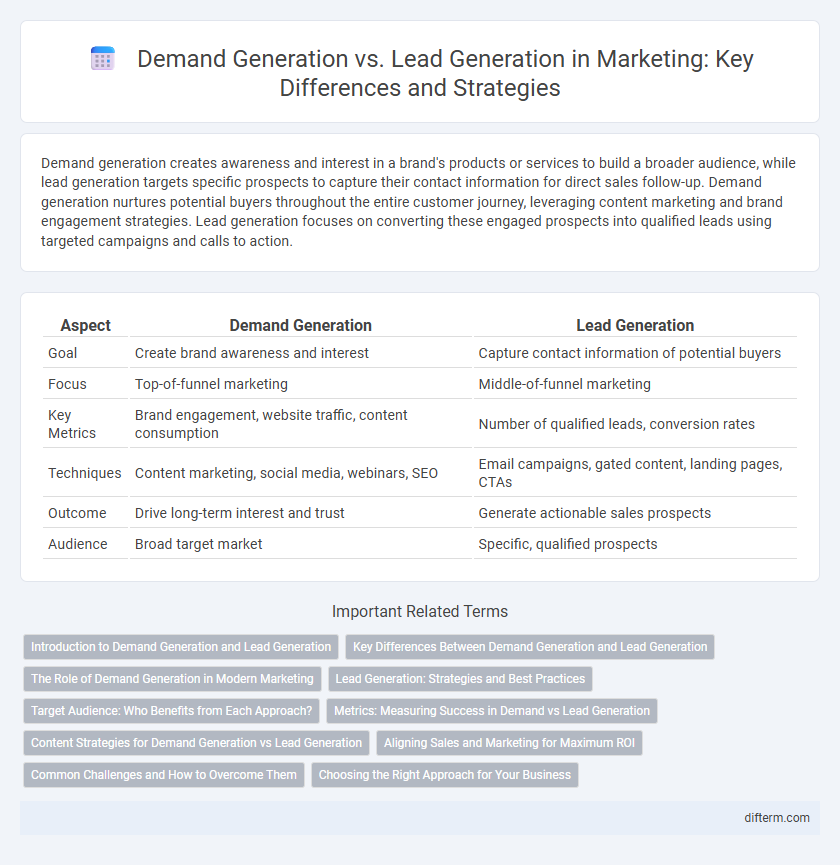Demand generation creates awareness and interest in a brand's products or services to build a broader audience, while lead generation targets specific prospects to capture their contact information for direct sales follow-up. Demand generation nurtures potential buyers throughout the entire customer journey, leveraging content marketing and brand engagement strategies. Lead generation focuses on converting these engaged prospects into qualified leads using targeted campaigns and calls to action.
Table of Comparison
| Aspect | Demand Generation | Lead Generation |
|---|---|---|
| Goal | Create brand awareness and interest | Capture contact information of potential buyers |
| Focus | Top-of-funnel marketing | Middle-of-funnel marketing |
| Key Metrics | Brand engagement, website traffic, content consumption | Number of qualified leads, conversion rates |
| Techniques | Content marketing, social media, webinars, SEO | Email campaigns, gated content, landing pages, CTAs |
| Outcome | Drive long-term interest and trust | Generate actionable sales prospects |
| Audience | Broad target market | Specific, qualified prospects |
Introduction to Demand Generation and Lead Generation
Demand generation focuses on creating awareness and interest in a company's products or services through strategic content marketing, targeted campaigns, and brand building efforts. Lead generation specifically aims to capture information from potential customers, converting engaged prospects into qualified leads for sales teams using tactics such as gated content, landing pages, and contact forms. Both demand generation and lead generation work together to drive revenue growth by first building demand and then nurturing leads through the sales funnel.
Key Differences Between Demand Generation and Lead Generation
Demand generation focuses on creating awareness and interest in a brand or product across a broad audience, whereas lead generation targets capturing contact information from potential customers for direct follow-up. Demand generation strategies emphasize long-term brand engagement and nurturing, using content marketing, social media, and SEO to build trust and credibility. Lead generation prioritizes short-term conversion tactics like gated content, webinars, and personalized offers to turn prospects into qualified leads for the sales team.
The Role of Demand Generation in Modern Marketing
Demand generation plays a crucial role in modern marketing by creating awareness and interest across the entire buyer journey, rather than focusing solely on capturing immediate leads. It drives long-term revenue growth through strategic content marketing, targeted campaigns, and multi-channel engagement that nurtures prospects. Unlike lead generation, which emphasizes direct contact information acquisition, demand generation builds brand authority and customer trust, ultimately increasing high-quality lead inflow.
Lead Generation: Strategies and Best Practices
Lead generation focuses on capturing potential customer information through targeted strategies such as content offers, landing pages, and email marketing campaigns to build a qualified sales pipeline. Effective lead generation best practices include leveraging personalized messaging, using clear calls-to-action, and employing marketing automation tools to nurture leads efficiently. Tracking key metrics like conversion rate, cost per lead, and lead quality ensures continuous optimization of lead generation efforts for maximum ROI.
Target Audience: Who Benefits from Each Approach?
Demand generation primarily benefits brand marketers aiming to build long-term relationships by increasing overall awareness and engagement within a broad target audience. Lead generation targets sales teams and revenue-focused marketers concentrating on capturing specific contact information from prospects ready for direct sales outreach. Businesses blending both strategies optimize the marketing funnel by nurturing prospects early while accelerating qualified lead acquisition for conversion.
Metrics: Measuring Success in Demand vs Lead Generation
Demand generation metrics prioritize overall brand awareness, website traffic growth, and engagement rates across multiple channels to assess the effectiveness of creating market interest. Lead generation metrics focus on tracking the number of qualified leads, conversion rates, cost per lead, and pipeline velocity to directly evaluate sales-ready prospects. Both approaches require analytics tools that integrate CRM and marketing automation platforms for real-time measurement and optimization.
Content Strategies for Demand Generation vs Lead Generation
Content strategies for demand generation emphasize educational and engaging materials such as blogs, whitepapers, and webinars to create brand awareness and nurture interest across a broader audience. Lead generation content tactics prioritize targeted calls-to-action, gated resources like eBooks and case studies, and personalized email campaigns designed to capture contact information and qualify prospects. Integrating SEO-driven content with data analytics enhances both demand and lead generation efforts by aligning messaging with customer intent and buying stages.
Aligning Sales and Marketing for Maximum ROI
Aligning sales and marketing teams through integrated demand generation and lead generation strategies significantly enhances revenue growth and ROI. Demand generation cultivates brand awareness and nurtures prospects, while lead generation targets qualified leads ready for sales engagement, creating a seamless pipeline. Synchronizing messaging, data sharing, and performance metrics ensures efficient resource allocation and maximizes conversion rates across the buyer's journey.
Common Challenges and How to Overcome Them
Demand generation and lead generation often face common challenges such as ineffective targeting, low-quality leads, and poor alignment between sales and marketing teams. Overcoming these obstacles requires leveraging data-driven audience segmentation, creating engaging content tailored to buyer personas, and implementing strong collaboration tools to ensure seamless communication across departments. Optimizing marketing automation platforms and continuously analyzing campaign metrics helps refine strategies for higher conversion rates and sustained pipeline growth.
Choosing the Right Approach for Your Business
Demand generation focuses on building long-term brand awareness and nurturing potential customers throughout the entire buyer journey, while lead generation targets capturing immediate contact information from prospects ready to engage. Selecting the right approach depends on your business goals, sales cycle length, and market maturity, with demand generation ideal for complex products and lead generation suited for fast sales conversions. An integrated strategy often maximizes ROI by aligning brand-building efforts with targeted lead capture campaigns.
demand generation vs lead generation Infographic

 difterm.com
difterm.com